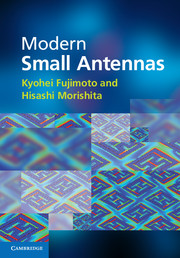Book contents
- Frontmatter
- Contents
- Preface
- Acknowledgements
- 1 Introduction
- 2 Small antennas
- 3 Properties of small antennas
- 4 Fundamental limitations of small antennas
- 5 Subjects related with small antennas
- 6 Principles and techniques for making antennas small
- 7 Design and practice of small antennas I
- 8 Design and practice of small antennas II
- 9 Evaluation of small antenna performance
- 10 Electromagnetic simulation
- 11 Glossary
- Index
- References
1 - Introduction
Published online by Cambridge University Press: 05 January 2014
- Frontmatter
- Contents
- Preface
- Acknowledgements
- 1 Introduction
- 2 Small antennas
- 3 Properties of small antennas
- 4 Fundamental limitations of small antennas
- 5 Subjects related with small antennas
- 6 Principles and techniques for making antennas small
- 7 Design and practice of small antennas I
- 8 Design and practice of small antennas II
- 9 Evaluation of small antenna performance
- 10 Electromagnetic simulation
- 11 Glossary
- Index
- References
Summary
The antenna first used in radio communication was a small antenna, which was a fan-type monopole (Figure 1.1), developed by G. Marconi, used for trans-Atlantic Ocean communication in 1901 [1]. The antenna appeared to be very large, as it was hung by two masts 48 meters high and 60 meters apart so that it could never be considered small [1]; however, since the dimensions were a small fraction of wavelength (about 1/6 of the operating wavelength, 366 meters), it was “electrically” small.
An Electrically Small Antenna – ESA – (the definition is described in 2.1) is an antenna of dimensions much smaller than the wavelength. In the classical sense, there are two types of ESA; one is an electric element, which couples to the electric field and is referred to as a capacitive antenna, and another is a magnetic element (electric loop), which couples to the magnetic field and is referred to as an inductive antenna. These are ESA categories; however, many practical antennas are some combination of these two types. It should be noted that small electric and magnetic elements in the forms of dipoles and loops have been used since 1887 when Hertz successfully generated and detected electromagnetic waves and verified Maxwell's prediction [2]. His invention of such small antennas certainly proved his success in demonstrating existence of electromagnetic waves. Although more than 120 years have passed since Hertz's experiment, his small dipoles and loops shown in Figure 1.2 (a) and (b) were so basic that essentially the same antennas are still being used.
- Type
- Chapter
- Information
- Modern Small Antennas , pp. 1 - 7Publisher: Cambridge University PressPrint publication year: 2014



